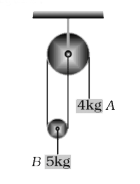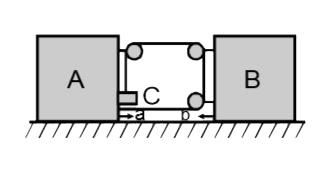For the system as shown in fig. find the acceleration of C. the accelerations of A and B with respect to ground are marked.

Video Solution
Text Solution
Sum of segment lengths should be zero.
(−xA)+(2xB)+xC=0
or xA=2xB+xC
or aA=2aB+aC
5=2×2+aC
⇒aC=1ms−2

|
Topper's Solved these Questions
- NEWTON'S LAWS OF MOTION 1Book:CENGAGE PHYSICSChapter:NEWTON'S LAWS OF MOTION 1Exercise:Exercise 6.4
Explore 13 Videos
- NEWTON'S LAWS OF MOTION 1Book:CENGAGE PHYSICSChapter:NEWTON'S LAWS OF MOTION 1Exercise:Subjective
Explore 15 Videos
- NEWTON'S LAWS OF MOTION 1Book:CENGAGE PHYSICSChapter:NEWTON'S LAWS OF MOTION 1Exercise:Exercise 6.2
Explore 35 Videos
- MISCELLANEOUS VOLUME 2Book:CENGAGE PHYSICSChapter:MISCELLANEOUS VOLUME 2Exercise:INTEGER_TYPE
Explore 10 Videos
- NEWTON'S LAWS OF MOTION 2Book:CENGAGE PHYSICSChapter:NEWTON'S LAWS OF MOTION 2Exercise:Integer type
Explore 1 Video
Similar Questions
Knowledge Check
For the system shown in figure, the acceleration of the block is :-
 A1m/s2B2m/s2C3m/s2D4m/s2
A1m/s2B2m/s2C3m/s2D4m/s2In the system shown in the figure the acceleration of 1kg mass is
 Ag4 downwardsBg2 downwardsCg2 upwardsDg4 upwards
Ag4 downwardsBg2 downwardsCg2 upwardsDg4 upwardsIn the system shown in the figure, the acceleration of 1 kg mass is
 Ag4downwardsBg2downwardsCg2upwardsDg4upwards
Ag4downwardsBg2downwardsCg2upwardsDg4upwards
In the fig, find the acceleration of mass m2 .
View SolutionFind the relation in the accelerations of the three masses shown in fig.

View SolutionIn the system shown in the figure, the acceleration of 1 kg block is

View SolutionConsider the situation shown in the figure.

Find acceleration of B.
View SolutionIn the adjoining figure if acceleration of M with respect to ground is a then

View Solution


